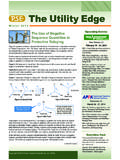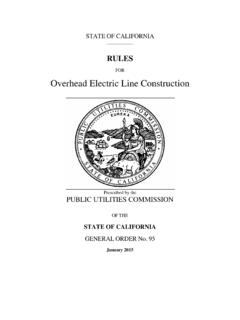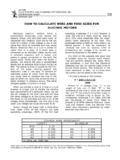Transcription of Understanding Per-Unit Indiana Electric Quantities …
1 Published by Power System Engineering, 2015 Understanding Per-Unit QuantitiesIn power system analysis, it is common practice to use Per-Unit Quantities for analyzing and communicating voltage, current, power, and impedance values. These Per-Unit Quantities are normalized or scaled on a selected base, as shown in the equation below, allowing engineers to simplify power system calculations with multiple voltage Events: 2015 Power System Engineering, Inc. (PSE)Continued on page 2 PSE Chosen to SpeakDistribuTECH s2016 Utility University (UU)Orlando, FLFebruary 9, 2016 PSE s Rick Schmidt will present:Field Area Network Communications OverviewIndiana Electric Cooperatives (IEC)Annual MeetingIndianapolis, INDecember 7 - 8, 2015 PSE will attend and have a booth at the annual :actual quantitybase quantityper unit quantity =For example, a transmission system operating at 117,300 volts with a nominal base rating of 115,000 volts has a Per-Unit voltage quantity of or 102% of nominal.
2 Likewise, a distribution system operating at 12,100 volts with a nominal base rating of 12,470 volts has a Per-Unit voltage quantity of or 97% of quantity = per unit quantity x 100 While most engineers studying transmission systems will evaluate analysis results in a Per-Unit value as shown above, those studying distribution systems will typically convert the Per-Unit value to voltage value using a 120 volt base. So for the above example, the distribution system with an operating voltage of per unit would be converted to volts on a 120 volt ,300 Volts115,000 Volts= PU12,100 Volts12,470 Volts= PUper unit quantity x base quantity = actual x 120 Volts = VoltsHistorically, Per-Unit values have made power calculations performed by hand much simpler. With many calculations now being done using computer software, this is no longer the primary advantage; however, some advantages still exist.
3 For example, when analyzing voltage on a larger system scale with many different nominal voltages via step-up and step-down transformers, Per-Unit Quantities provide an easy way to assess the condition of the entire system without verifying the specific nominal voltage of each subsystem. Another advantage is the fact that Per-Unit Quantities tend to fall in a relatively narrow range, making it easy to identify incorrect data. In addition to these advantages, most power flow analysis software requires input and reports results per unit . For these reasons, it is important for engineers and technicians to understand the Per-Unit concept. PSE Chosen to SpeakNew Orleans, LAFebruary 15 - 18, 2016 PSE s Erik Sonju and Charles Plummer will present:Confronting the Age of an Aging Electric Utility InfrastructureNRECA Releases Solar Case Studies Authored by PSEThe case studies highlight some of the innovative ways cooperatives are satisfying their members demand for solar-derived NRECA s website to access the case studies.
4 2 PSE / / The Utility EdgeIn three-phase power systems, voltage and apparent power (VA) are typically chosen as bases; from these, current, impedance, and admittance bases can be determined using the following from page 1 Understanding Per-Unit QuantitiesPer- unit impedance calculations continuedFor equipment such as motors, generators, and transformers, the base power rating and voltage are typically used to calculate a Per-Unit impedance. In some instances it is necessary to convert these Per-Unit values with different power and voltage bases to one common base. The power base will remain constant throughout the system, and the voltage base is typically the nominal voltage for each part of the system. The equation for converting to a new impedance base is as follows:Apparent Power Base, VA 3f3 X Voltage Base, VLLI base =Voltage Base, VLL3 X Base current (A)Zbase ==(Voltage Base, VLL ) 2 Apparent Power Base, VA 3f1 ZbaseYbase =ZPU NEW = ZPU OLDbaseVOLD baseVNEW()2baseVANEW baseVAOLD()Submitted by Doug F.
5 Joens, PE Manager, Power Delivery Planning a 100 MVA apparent power base and the nominal base voltages shown in Figure 1 below, the following is a conversion of the impedances and the measured voltages to Per-Unit Impedance CalculationsGENERATORZPU NEW = . kV()2100 MVA55 MVA()= = (115 kV) 2 100 MVA= (W)TRANSFORMER 1 ZPU NEW = .10115 kV115 kV()2100 MVA55 MVA()= PU = W= .00966X PU = W= .05181B PU = S= .008164 Ybase = .0076 (S)TRANSFORMER 2 ZPU NEW = .08115 kV115 kV()2100 MVA20 MVA()= NEW = . kV()2100 MVA6 MVA()= Voltage CalculationsBUS 1 VPU = kV= 2 VPU = kV115 kV= 3 VPU = kV115 kV= 4 VPU = kV= Impedance55 kVBus 1* kVTX 110% Impedance50 kV - 115 kV* kVBus kV Base115 kV BaseR= ( )X= ( )B= -5 (S)Bus 3* kVTX 28% Impedance20 MVA115 kV15% Impedance6 kV Base* kVBus 4GM*Measured bus voltageFigure 1: Example of conversion to Per-Unit Quantities .
6 Similar to the wireless phone service carriers offering prepaid cell phone plans, Electric utilities around the country are transitioning toward allowing their customers to pre-purchase electricity under the pay-as-you-go or prepaid metering programs an alternative to the traditional post-pay concept. Statistics indicate that currently, around 200 Electric utilities across 34 states in the nation are employing or piloting prepaid metering the pay-as-you-go scenario, Electric service remains connected as long as the balance on the account is positive. To help ensure continuity of service, customers receive daily alerts via text, email, web portal, or phone message with account balance and usage information. Payment options for prepaid accounts include payment by phone, on the web (if using debit/credit card), or in person at designated payment locations.
7 However, under the prepaid service arrangements, customers are not limited to a payment due date but have the convenience of initiating payments on their own schedule, allowing for smaller, more frequent payments. Prepaid metering programs help customers break the vicious cycle of ever-increasing balances caused by late charges and other collection fees, while enabling the utility to reduce past due accounts. Under prepaid metering, utilities waive the traditional deposit. Due to remote connect/disconnect capabilities of the Automated Metering Infrastructure (AMI) system, the disconnection/reconnection service charges are lowered substantially or eliminated. There are also no late fees under the programs. Furthermore, the prepaid metering programs can be structured so that a customer may roll over an existing past-due balance.
8 Then, each time a payment is made, a certain percentage of that payment is applied toward the old balance. Energy efficiency is another positive outcome being observed with prepaid metering programs; , as customers become more aware of their daily energy usage, they are better equipped to change their behavior accordingly. As a result, a conservation effect around 10-12% per participant often accompanies the prepaid metering program roll-out. To assess and justify a planned residential prepaid metering program to its directors or a regulatory agency, a utility should conduct a benefit-cost analysis (BCA) which includes the following: Ratepayer Impact Measure (RIM), Total Resource Cost (TRC), Program Administrator Cost (PAC), and Participant tests. These tests examine the benefits and costs and provide summary information from the various perspectives of the program participant, the non-participating ratepayers, the utility, and society as a by Elena Kanaeva-Larson Rate and Financial Analyst Trend: Prepaid MeteringPage 3 PSE / / The Utility EdgeNew Technology and Organizational Change: The Product Management ApproachWe are seeing a growing list of new products and services piloted and deployed at medium and larger-sized utilities.
9 These include prepaid metering, direct load control for residential, new time-of-use (TOU) pricing programs for both residential and commercial, smart thermostat for residential, new web hosting content, Electric vehicle charging devices and installation, deployment of commercial energy management systems with the new OpenADR protocol, lighting services, and often try to manage a combination of these new products and services using their existing departmental structures. While the existing structures have fairly clear lines of demarcation, this can often lead to complications and confusion regarding ownership and prioritization between competing initiatives. Introducing new products and services requires well-coordinated efforts between several departments, including: Business process review and changesAppropriate training with the new products/servicesField or premise installation and maintenance processes Coordinated marketing and advertising Buy-in from management and all affected departments, including IT, which often has a major role with new product/servicesSimilar issues occurred within the telephone industry post-1990, when many new products were introduced (caller ID, voicemail, long distance services, cellular, and eventually Internet access for the home or business).
10 Prior to that, telcos had a single product. The resultant output of so many new services was the adoption of a new product management structure to oversee the introduction and the day-to-day management of their new products/services. The product management group coordinated various departments throughout every step of the process including maintaining primary responsibility for managing sales, revenues, and costs. There are definite benefits for Electric utilities to adopt similar organizational changes by employing a product management structure to best manage the diverse disciplines of the introduction, deployment, and maintenance of new products and services. PSE recommends considering this approach in your next strategic technology plan by Rick Schmidt Vice President, Utility Automation and Communications 4 PSE / / The Utility EdgeASK PSE A QUESTIONAre There Affordable GIS Options Available to Smaller Utilities?










